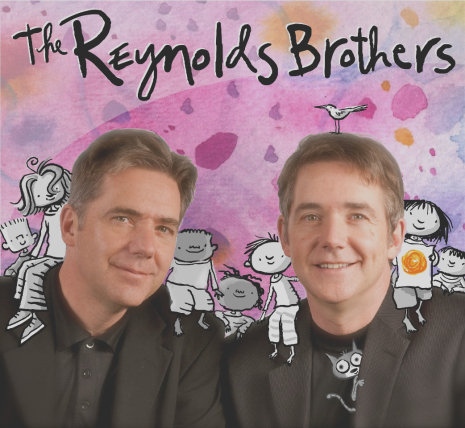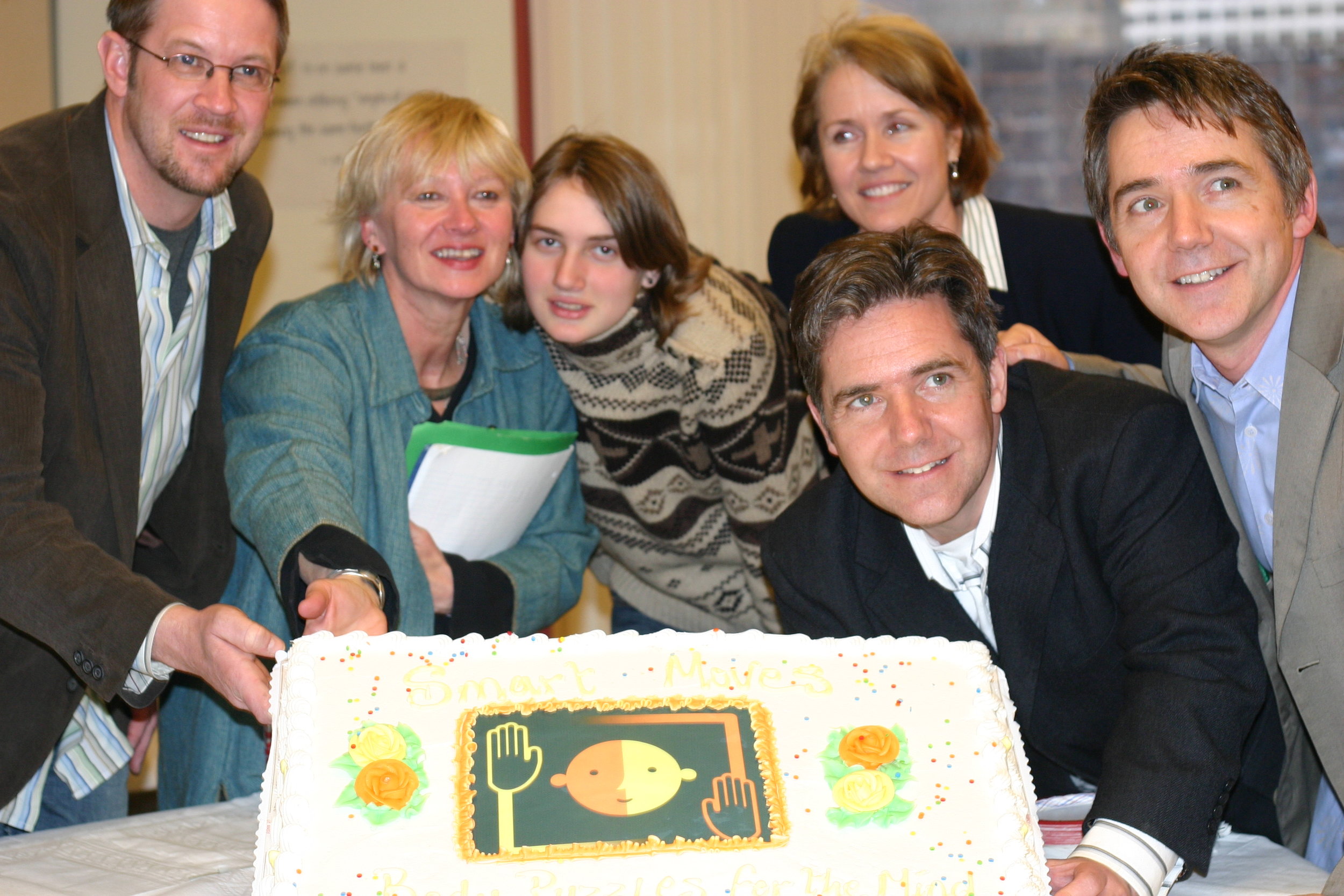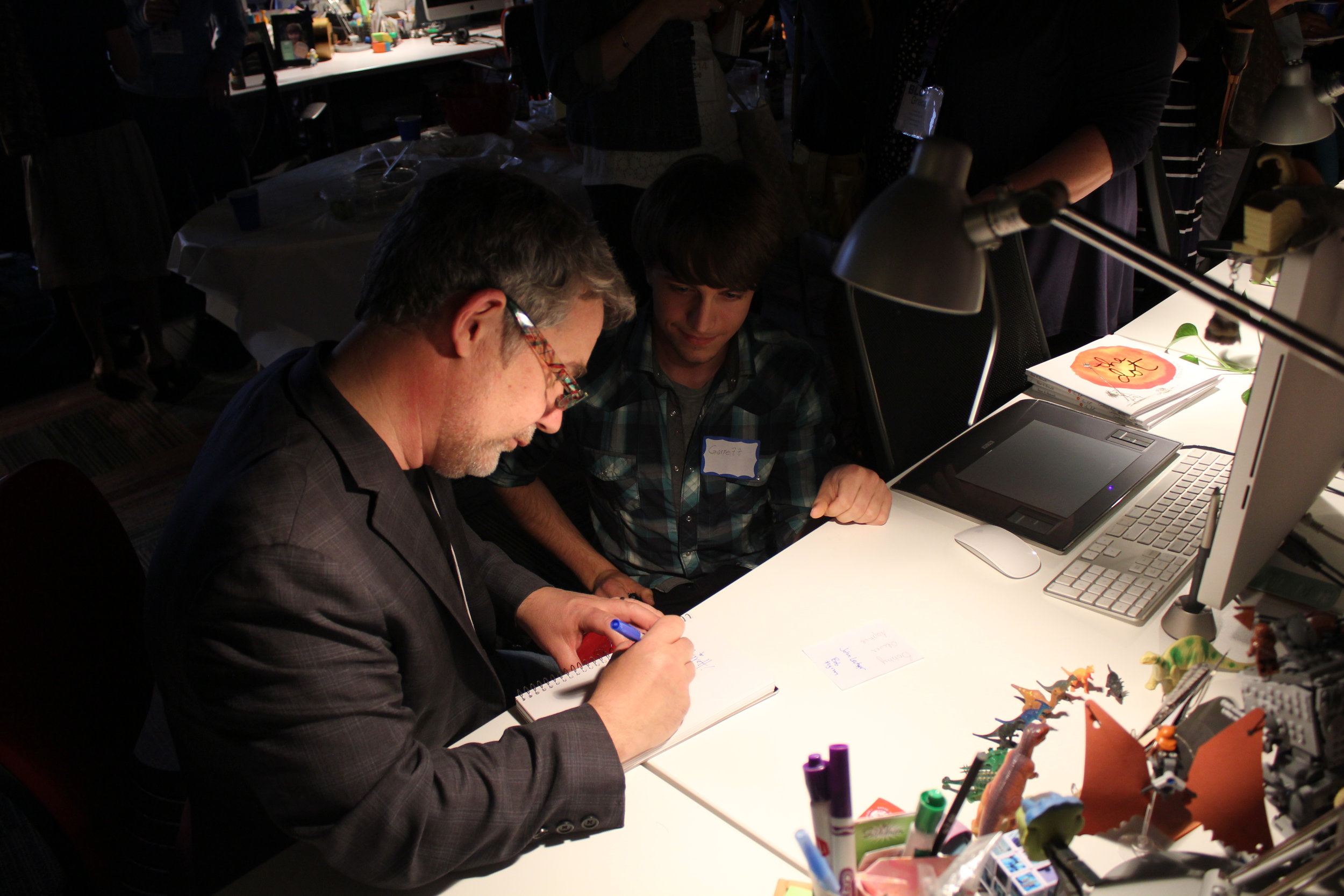How FableVision Began
The Secret to Surviving & Thriving for 20 Years as a Creative Studio
This special-edition FableFriday features an interview with FableVision founder Peter H. Reynolds. This is a special year for FableVision. We’re celebrating 20 years of designing and developing a wide array of engaging media that have inspired, taught, and moved people to action.
FableVision operates under the “it takes a village” mentality. Everyone contributes to our mission-driven work, but it’s impossible to ignore Peter’s insatiable appetite for quality media for learners of all ages and his unending optimism, positivity, and innovative leadership. An international advocate for creativity, his vision led to FableVision. We sat down with Peter to hear the story of FableVision, a story that begins with a talented crop of characters, innovative fledgling ideas, and the power of teamwork to create a brick and mortar safe harbor for the Boston creative community to flourish.
Read up on all our anniversary celebrations on our website here and save the date for our anniversary party on November 18!
Twenty years! What a journey! How does that feel?
It’s an extraordinary milestone. It’s hard to believe all those years have flown by. In some ways it feels like yesterday, but I look at everything we have done and it also feels like a lifetime. I’m really proud that for the past two decades, FableVision has been a safe harbor for creative people, looking for that dream job and having found it. We have gathered some really extraordinary talent all dedicated to making really great media. The story of FableVision is really a story about everyone who has ever worked with us.
Tell us about that extraordinary talent.
Do you have a few weeks? There’s a lot to tell! There are all the employees we’ve had, all the freelancers—New England has an incredible pool of talent to draw upon—all the interns—and all the amazing clients we have collaborated with. That’s the great part of a true studio. It’s not been successful because of one person. It’s all of us together.
Among the legion of talent, it was the talent and dedication of the FableVision “Founding Fathers” who really got the ship built and out to sea for its remarkable two-decade voyage. Gary, John, and Paul. Sounds like the Beatles, right? It was more than talent though. It was commitment to the vision and a sense that we were building something really special.
How did you and Gary Goldberger connect?
I tapped Gary on the shoulder for a 3D animated sequence, which I storyboarded on a napkin. He said he could do it, but first had to a) find a machine capable (which in 1996 was no easy task!) and b) tear through a thick manual and teach himself HOW to animate in 3D. In a matter of weeks, I was watching a spectacular 3D opening sequence and my jaw dropped. The camera flew through the stars, through clouds, to a planet and a fantastic world… the City of Imagination, The City of Discovery, and the City of Sharing… and the elevated high-speed train that connected all the cities in an inviting loop. It was my theory of learning come to life. Gary had not only brought it to life, but he had fallen in love with this metaphor for learning. It sparked some great conversations that went way beyond animation and technology.
Gary was immediately drawn to the core mission. I remember us coining the mission as “PEL: The Positive Evolution of Life.” We wanted to use stories, technology and media to spark thinking about big ideas—and igniting action to make the world a better place. That eventually evolved into our tagline: “Stories that Matter, Stories That Move” and our mantra that we had embarked on the “200 year mission”—recognizing that true and lasting change take patience and perseverance.
For a guy who rode a motorcycle to work and had magenta hair, I think I was surprised—delightfully so—that he also had a natural sense for business. Gary became a dear friend, but also a stalwart captain of the ship. I saw him grow from a young man into a studio elder—steady and kind—but still relentless in his commitment to the team and the growth of the studio.
John Lechner has been by your side from day one. How’d you “connect the dots” with him?
John was freelancing back in the early nineties and had landed a job designing local telephone book “yellow pages” ads. (True story!) There was one particular image he showed me from his portfolio when visiting me trying to land some freelance work. It was a wonderfully elaborate forest; I was stunned by the detail and the overall spirit of the piece. It was then that I committed myself to tap into John’s talents for something special. I knew this special talent was destined to be used for meaningful work. He joined the studio, and among hundreds of projects, he helped direct and produce several of my stories into animated films—including The Dot, Ish, Sky Color and The North Star. I’ll be forever indebted to John Lechner’s tireless efforts to do whatever it took to build the studio. His comfort with technology at a time when the internet was in its infancy and we were still copying files to disks, was a boon. His sense of humor helped define the whimsy of FableVision and kept our mission grounded and accessible.
So when did you meet Paul? Just kidding, but seriously what brought you two together professionally?
Teaming up with my twin brother Paul was a dream come true. Besides the obvious fact that twins are often in sync in mysterious ways, he also had logged in a decade plus building a studio with his business partner, and early believer in the FableVision mission, Bill Churchill. It set the stage for the aligning of stars to start the new studio.
In the mid-nineties, Paul and I worked a mile apart from each other. I would meet Paul at the Taco Bell at the Watertown Mall situated precisely halfway in between his company and Tom Snyder Productions. Eventually at one of those lunches, over a bean burrito, we realized that we really should be working together. So we did. Twenty years later, Paul is as committed as ever. He is a visionary, a storyteller, a creative problem solver, and an amazing human being. He also has an amazing sense for finding partners to help drive the mission forward. Paul always refers to our clients as partners because he really believes that we are equally committed to getting great media made to make the world a better place. Paul’s indefatigable drive, compassion, and optimism allowed him to guide the studio through very tough times. His vision for “what’s next” is inspiring. He’s far from finished. In some ways, I feel he has just begun.
The original FableVision crew.
You dreamed up with the name “FableVision.” Where did that come from?
I knew our studio needed a good name to describe what we were setting out to do—and I knew that story was the center of all the spokes in the creative wheel. Stories to inform, enlighten, inspire. Teaching stories. Fables. That was it—FABLE. I toggled through some words to weld to Fable. FableFarm. FableStable. FableVille. I came across the word VISION. The ability to see, but also the ability to see something that does not yet exist. FABLEVISION. That was it. Done.
You not only came up with the name but you designed the logo, true?
True—though I didn’t do much thinking about it. It just poured out the first time I gave it a shot. I dashed out the words “FableVision” using my digital pen and tablet and Autodesk Animator while at our historic “Let’s Build A Studio” retreat in Portsmouth, NH. (I got to the retreat, by the way, riding on the back of Gary Goldberger’s motorcycle.) I selected the “star tool,” made an orange star and then squashed it, and popped it behind the black lettering. When I showed my rendition of the studio name, the group all exclaimed, “That’s it! That’s our logo!” Bedsides a bit of tightening up in Illustrator, the logo remained the same for 20 years, even after a few attempts to rethink it.
(For the record that gathering consisted of Bill Churchill, Geraldine Churchill, Julie Ogles, Paul Reynolds, Gary Goldberger, John Lechner, Donna Meguire, and Bob Keough.)
Was there a precise moment where the concept for FableVision began?
The seed of FableVision was planted a good year before we officially opened the studio. I was at Tom Snyder Productions (which I joined back 1982) as VP/Creative Director, and I was charged with getting two educational products created and shipping in a year. I created an in-house studio to get it done. Inspired by my mentor, Tom Snyder (teacher extraordinaire and media pioneer), who had created his own studio within his own company called the RetroRanch. He shared his philosophy that for an artist to create something truly authentic, they had to have their own studio. He even had a song back in the early ‘80s called “My Room Is A Studio”—packaged with a music-making product we created titled “Rock N’ Rhythm.” This belief that a creative sanctuary was key to crafting, experimenting, collaborating, making, producing had a huge impact on me.
Ironic that it was a yet another teacher who inspired you?
Right? It was my 7th grade math teacher, Richard Matson, who “connected the dots” with the media teacher, James K. Morrow who—nine years later— “connected the dots” with Tom who was teaching at Shady Hill and bicycling to his educational software company he had just launched and then asked me to join. I owe HUGE thanks to Tom who truly changed my life and allowed me to grow and learn beside him. He taught me so much in those formative years. He was a master teacher with a rock and roll spirit. I do think that rebel soul rubbed off on me. He inspired me to take chances and push back on what didn’t make sense in the world.
So back in 1996, you put the FableVision name on the door. What were you working on in those early days?
My little fledgling studio created Pip & Zena’s Science Voyage and Tri-City Science Club. Annette Donnolly, John Lechner, Kathy Venske, Julia Papps, and Bob Keough all worked hard to produce two laserdisc packages to introduce kids to science and the scientific method. I personally think these two kits were some of the best work of my career, but sadly Tom Snyder Productions was sold shortly after they were created and were discontinued by TSP’s eventual owner, Scholastic. It was 1996 when the company was sold and I had a big choice to make. Stay with Tom Snyder Productions under new ownership or to set up my own shop.
You were lucky with finding people who believed in you. That seems to be a big theme in your books.
I am incredibly lucky. My history of FableVision’s origination would not be complete with out a special shout out to Bill Churchill whose company, CF Video/Cosmic Blender made room for FableVision in a small office he rented to us. He was so encouraging. He and my twin brother Paul, who was a partner at CF/CB both welcomed FableVision and brought a big animation gig to our group. It was an animated soap opera to teach Sheraton Hotel employees how to wow the customer. While it might seem a slightly odd choice for a young studio out to change the world, it taught us a fundamental truth. That adults needed to learn in creative ways too, that the learning journey never ends, and that we were in fact, interested in learning whenever and where ever it happens. We were not a children’s media company. We were a learning company. A human development company. A community development company.
Was FableVision technically a part of Cosmic Blender?
Well, it was. Bill Churchill originally had envisioned FableVision becoming the animation division of his media company, but he needed cash to invest in the burgeoning interactive arm of Cosmic Blender which was a very expensive endeavor back in the day when a 2GB video storage drive cost $6K. I bought the company and FableVision was officially an independent company.
That must have been a bit scary to go out on your own, no?
Actually, it was exhilarating. Anyone who dives off a cliff has to think it’s going to be an awesome trip or else fear takes over and the landing is anything but fun. Fortunately for me, my team added one extraordinary person from the Cosmic Blender staff: Karen Bresnahan. As Executive Producer, she calmly took the reins of ALL projects—finding producers and staff to get them all over the finish line. Without Karen by our side for both of these amazing decades, we couldn’t have made all the extraordinary FableVision milestones.
Was it difficult to build a creative studio but also build a sustainable business?
Paul and I were blessed to have been born with DNA from our parents who were both business people. Mum was a bookkeeper and Dad was a treasurer. Paul and I discovered that the right and the left side of our brains were both firing nicely, but we also knew that we needed a dedicated person to making the business run well. We added Adam Landry as our “profit engineer.” I credit his drive and creative maneuvering for keeping the FableVision ship afloat and moving forward all these years and as we sail by this 20-year milestone. Adam has also become a trusted friend and an enthusiastic builder of all things FableVision. He was equally excited to help set up and guide our not-for-profit Reynolds Center for Teaching, Learning, and Creativity.
Bill Churchill must be pleased to see what he helped incubate all those years ago.
He is proud of us—cheering us on continually. I’m glad he kept a little slice ofownership of FableVision—just big enough a token to say he’s still on board which makes me happy. He happily attends our yearly shareholders’ meeting and toasts to our success and we toast to him—thanking him for believing in us in the early days and making it possible.
Bill Norris and Peter Reynolds.
There’s another Bill to thank, yes?
Another nod goes to Bill Norris who I met when he was at MCET (Massachusetts Corporation for Educational Technology) which funded those first two projects. Bill, an educator for many years in the Watertown Public Schools, had appreciated my design philosophy and later helped fund BrainCogs and EssayExpress—both projects designed to help struggling students learn executive functioning skills. Bill would join us a few years after as part of the core team. His hard work, his humor, but above all—his caring of others—has inspired all of us on the team. Though the good times and the lean times, Bill has always said, “It’s all about the mission.”
You often refer to the early days as “The ‘Dawn’ of FableVision.”
Yes! Dawn Haley Morton! Dawn joined our growing team shortly after we launched. She was “den mother” to the crew. Talented, funny, and ready to do whatever it took to tend the growing studio, she saw us through the early years and into our new home at the Boston Children’s Museum. Her quirky sense of humor and her above and beyond TLC for clients set the standard for FableVision.
What’s your final thought on the magic recipe of FableVision?
My recipe is simple. Gather amazing people, stand back and let them amaze you, and they’ll amaze the world. Everything else falls into place when you believe in people potential and provide them a safe, creative place to make it happen.
The FableVision team at their 2015 holiday party.
Anything else you’d like to add?
The task to recognize all the contributions to our 20 years is next to impossible. From my brother, Andrew who guided the finances in our early days and helped project manage the build out of the new FableVision home at the Children’s Museum to my sister, Jane who invested her time, talent, business acumen into the growth of our spin-off educational company, FableVision Learning—the list is impossibly long.
The list would include Kathy Loukos: who oversees the entire financial operation, Tone Thyne: who is building out our television division, Terry Shay: who is our Lead Ambassador of our 200-strong cadre of FableVision Learning Ambassadors, as well as superstar creative director: Leigh Hallisey, techno-whizzes Brian Grossman, Jordan Bach, Matt Brelsford, and Margarita Dekoli, marketing mavens: Sarah Ditkoff and Mitul Daiyan, renaissance woman: Andrea Calvin, creative wunderkind: Patrick Condon, solutions architect: Shelby Marshall, strategic visioneer: Cecilia Lenk, power-producers: Polly Searles, Peter Stidwill, Michael Fogarasi, and Sam Zollman, animator-extraordinaires: Didi Hatcher, Sonnye Lim, and Hannah O’Neal, artistic design squad: Bob Flynn, Keith Zulawnik, Loren Lee-Flynn, and Christina Kelly, as well as recent partners: Geoff Wood and Rich Lanchantin, who are expanding our educational products spin-off, FableVision Learning. I told you the list would be long!
So, what can we expect in the next 20 years?
It’s fun to think about. When I drive by a pre-school, I look at those kids running around wildly and think: “They are the future staff at FableVision! Our next generation animators, programmers, writers, and producers—who will hopefully keep all that great kid-energy and bring it to our studio!”





























